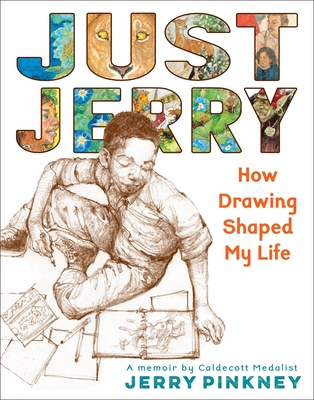 Just Jerry: How Drawing Shaped My Life
Just Jerry: How Drawing Shaped My Life
Written & illustrated by Jerry Pinkney
Little, Brown & Co, 2023, 147 pp
ISBN: 978-0316383851
Award-winning author and illustrator Jerry Pinkney worked on his memoir during the decade before his death in 2021. While the published memoir is not as Jerry had envisioned with colorful illustrations and panels, the notes and sketches that composed the manuscript were detailed enough so the unnamed editor could publish the memoir. The memoir is organized in concentric circles. Pinkney first explores relationships with the family circle in his home, then expands to his neighborhood and school. He concludes with places that stretched his growth dramatically when he describes discovering nature through a visit to rural New Jersey, then getting a job selling newspapers where he met a professional artist, and finally moving into high school and college studies and eventual employment in the art field. Jerry’s reflections about his life at times move back and forth across those circles, but the detailed timeline in the backmatter helps answer any sequential questions a reader might have.
The bulk of the memoir is focused on his early life. Growing up in a large family in Philadelphia in the 50’s and 60’s was not easy for someone who was Black and struggling with undiagnosed dyslexia. Pinkney describes the Black neighborhood where it was safer, and where his parents had settled after leaving the South and the Jim Crow limitations. He also describes how difficult school was as he struggled to keep words on the right lines, make sense of a text, or write his weekly spelling test. However what shines through the narrative is the perseverance and growth mindset that his parents instilled in him. With a pencil and paper, he captured moments or scenes from his day or drew animals and heroes from TV shows. A turning point was when a teacher called him the class artist and asked him to draw a fire engine so that the class would be able to understand the various parts of the vehicle. Another significant step in building his confidence as an artist was when he got a job selling newspapers. His boss would let him sketch when customers were slow, and one day someone noticed his drawing and asked to purchase it, and that was the beginning of his commercial venture, a nickel for a newspaper and a nickel for a drawing.
The illustrations for the book are sketches in sepia-toned ink that Jerry had planned on adding color to. Some are quick–the kind an artist draws to capture or remember a moment in time. For example, on page 75, Jerry sketched his memory of sitting on his bunk while he finished his drawing of the best part of the day, that of watching a tugboat pass under the bridge he was standing on. Other illustrations are more detailed. The drawing on page 45 depicts Jerry, his face nervous as he thought about going to school where he struggled with reading and writing, and beside him the concerned and loving face of his mother who understood how he was feeling and wanted to help. In an article in the New York Times, illustrator David Small (2023) reviewed Just Jerry and pointed out that “Pinkney’s pure, spontaneous drawing process has previously been hidden for the most part by his finished illustrations’ perfectionism. Not so in this posthumous memoir. . . These loose sketches reveal another, unbound side of Pinkney, a side that might never have been seen outside his archives had his work on this book not been interrupted. They are the visual equivalent of memory itself.”
Books that pair well with Just Jerry include award-winning titles that Pinkney illustrated, such as the Caldecott winner The Lion and the Mouse (2009), the Coretta Scott King winners The Patchwork Quilt (Valerie Flourney, 1985), Half a Moon and One Whole Star (Crescent Dragonwagon, 1986), Mirandy and Brother Wind (Patricia McKissack, 1988), Minty, A Story of Young Harriet Tubman (Alan Schroeder, 1996), and Goin’ Someplace Special (Patricia McKissack, 2001), or the New York Times Best Illustrated winner The Hired Hand: An African-American Folktale (Robert D. San Souci, 1997) and the Sydney Taylor Award winner Noah’s Ark (2002).
Titles that would also pair well with Just Jerry are other memoirs written by illustrators profiling their childhood or youth, such as Drawing from Memory (Allen Say, 2011), A First Time for Everything (Dan Santat, 2023) or Hey, Kiddo (Jarrett J. Krosoczka, 2018).
Jerry Pinkney (1939-2021) illustrated over 100 books across his career. He won many awards for his work and was nominated for the Hans Christian Andersen and Astrid Lindgren awards for his body of work and influence on children’s books. Perhaps his greatest legacy is the “Pinkney dynasty” that started with book collaborations with his wife, and continued with passing on his love of the arts to his four children, their spouses and grandchildren. His final book, A Walk in the Woods (2023), was a collaboration with poet Nikki Grimes, with illustrations finished posthumously by his son Brian Pinkney and granddaughter Charnelle Pinkney Barlow.
References
Small, D. Two Caldecott medal-winning illustrators tell their own stories. https://www.nytimes.com/2023/02/24/books/review/jerry-pinkney-dan-santat-graphic-memoirs.html
Storymakers with Nikki Grimes & Brian Pinkney: A Walk in the Woods. https://www.justjerrypinkney.com/#books100
Susan Corapi, Trinity International University
© 2023 by Susan Corapi

